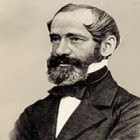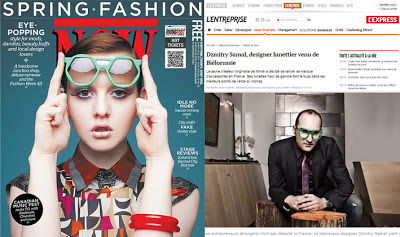What are Progressive lenses?
A progressive lens is an amazing piece of engineering, allowing multiple vision fields to be incorporated into a single lens without any clear distinction between the fields themselves. The power in the lenses "progressively" changes from far-to intermediate to your full reading power. This is why progressive lenses are often referred to as "no-line" bifocals or trifocals.
And it's why progressive lenses are ideal for patients who have presbyopia – a vision condition marked by a decrease in the ability to focus sharply on nearby objects.

As we age naturally, our ability to see nearby objects and objects in the distance can decrease. Progressive lenses address separate visual needs in one lens – usually with a "distance viewing" field build into the upper portion of the lens and a "near vision" field built into the lower portion. Rather than a line separating these areas, they are "blended" together, often with the middle portion of the lens serving as intermediate vision correction when necessary.

Unlike traditional bifocals or trifocals, there are no visible lines separating the different fields of a progressive lens. Your eyes are seen clearly behind the progressive eyeglasses, you've got the same "look" as eyeglass wearers often half your age, and there are no "lens lines" to distract your vision.
How it started
On 17 November 1846, the 30-year old mechanic Carl Zeiss opened a workshop and a small store in Jena’s Neugasse No. 7. In just a few months, Zeiss, who not only had a solid theoretical basis and good practical experience, but was also well acquainted with scientists and mathematicians at the University of Jena, had already found clientele for whom he repaired scientific apparatuses and instruments or produced them according to the customer’s specifications. In addition, he offered spectacles, chemical scales, drawing apparatuses, telescopes, etc.
In 1847, his business success encouraged Zeiss to hire an assistant and an apprentice, and to rent two workrooms in Wagnergasse No. 34. In the summer of 1847, following the advice of his teacher, the botanist Mattias Jacob Schleiden, Zeiss devoted his attention to building a simple microscope. In September 1847, he produced the first loupe microscopes.

At the beginning of the 1850’s, there was an increase in the demand for observation instruments from the Zeiss workshops, which now enjoyed a good reputation among microscopists due to their meticulous workmanship. At the time, the level of interest shown by scientists and medical professionals in compound microscopes was growing because these were the only instruments that provided the higher magnifications they wanted.
The time-consuming trial-and-error method required to build optical systems initially kept Zeiss from building such instruments, particularly as he was convinced that there must be some scientific way of determining the individual elements of the optical systems. However, the competition forced him to build compound microscopes in the traditional way from 1857 onwards.
Early Years
Carl Zeiss is a company with a long tradition that was founded by Carl Zeiss in 1846 in Jena as a precision mechanics and optics workshop.

From 1872, microscopes made in Jena were built on the basis of scientific calculations and therefore displayed considerably improved optical properties. This technological lead, which earned the company global recognition, is attributable to the physicist and mathematician Ernst Abbe, who became a dormant partner in the optical workshop in 1876.
Abbe’s theory of image formation in the microscope and the “sine condition” that bears his name form the basis of all high-performance optics
Design
ZEISS Progressive Individual 2 (Clarlet Gradal Individual EyeFit)
The most individualised ZEISS progressive lens with optimum near zone.
ZEISS progressive lenses are now more individualized than ever before. Thanks to EyeFit Technology, the latest generation progressive lenses make it possible to also take into account the wearer’s personal visual behavior in near vision. This focuses the lenses sharply on the requirements of each individual patient, therefore guaranteeing natural vision at every distance.

The attractiveness of this leading edge product is further enhanced by technical innovations such as increased consideration of the position of the eye‘s centre of rotation, further reduction of the lens thickness and practical improvements for the patient consultation process in your practice.
The technical innovations at a glance
In addition to the outstanding features of its predecessor, the following innovations are integrated into the new product:
Individualisation of the near zones thanks to EyeFit Technology by ZEISS.
Optimised C.O.R.E. Technology allowing increased consideration of the eye‘s centre of rotation for each individual wearer.
Thinnest ZEISS progressive lens thanks to new mathematical optimisation methods.
New optional order parameters for more flexible lens choice.
For frames with high curvature available as ZEISS Single Vision Individual Sport (Gradal Individual Loop)
ZEISS Progressive Individual 2
The benefits for you & your patients at a glance.
The benefits for you at a glance:
Highest level of personalised patient care
Differentiates your practice by offering leading edge technology
Enhances premium product mix
More satisfi ed patients by solving a key concern of presbyobic patients` near vision performance
Possibility of selecting easy or expert order placement
OPTIMA online order placement free of charge
The benefits for your patients at a glance:
Natural vision from far to near
Maximum visual comfort thanks to wider zone sizes depending on wearer’s profile
Immediate wearer acceptance thanks to individualised balancing of all visual zone sizes
Individualised design for every patient
Optimum cosmetic appearance thanks to thin and light lenses































































